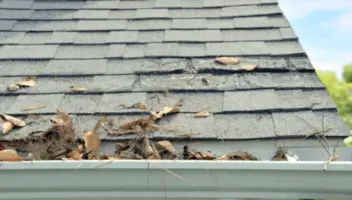How to Clean a Clogged Underground Downspout Drain

Underground gutter drains redirect water from your gutters away from your house, helping prevent foundation issues and ponding close to the house. Sounds great, right? Well, yes, underground downspout drains are excellent at doing what they’re designed to do… as long as they’re not clogged.
Just as you need to clean out your gutters regularly, if you have underground gutter drains, you need to make sure they’re cleaned out and flowing freely. Some signs that your gutter drain is clogged can include water pooling by the downspout connection, visibly overflowing gutters, water leaking into the basement, and even visible clogs at the end of the drain.
The good news is that there are several ways to clean out and unclog underground downspout drains. We’ll describe five of them in detail below.
In this article:
- What Are Underground Downspout Drains?
- Why is Proper Drainage Important?
- Identifying a Clogged Underground Downspout Drain
- 5 Ways to Unclog an Underground Downspout Drain
- Keeping Your Underground Downspout Drain Functional
- Frequently Asked Questions
What Are Underground Downspout Drains?
An underground downspout drain is a type of underground downspout and piping system that carries water from your gutter to an exit point to drain further away from your home, elsewhere in your yard. Unlike traditional downspout extensions, they don’t have to be moved or even visible around the home. This can increase the homeowner’s curb appeal while also diverting water away, which helps prevent foundation damage to the home.
Why is Proper Drainage Important?
A properly functioning gutter system protects your roof and home from water damage. Your downspout and any downspout drain are part of that system, allowing the water to drain away from the house. Proper drainage can help prevent foundation damage, basement flooding, and maintain the integrity of your landscaping. For instance, water pooling near your foundation can lead to cracks or structural settling over time.
Identifying a Clogged Underground Downspout Drain
Common Signs of a Clog
Unlike an above-ground downspout, it’s harder to detect a clog when the downspout is underground. Since you can’t see the clog firsthand in the buried drain, there are a few other telltale signs to watch for:
- Water pooling or water flow backing up and escaping near downspouts
- Overflowing gutters during rainfall
- Water stains on basement walls
- Damp or soggy areas in the yard
- Bad smell near the downspout from debris
Causes of a Clog
Downspouts, especially underground ones, can clog easily. With the rush of water from the gutter, these piping systems can collect debris and dirt. The accumulation of these things can create a clog or slow circulation of water. However, underground drains also have unique clogging causes:
- Underground drain pipe damage – can interrupt the flow of water to the exit point
- Perforated water pipes – causes water to escape elsewhere besides the drain exit
- Root growth in pipes – block the pathway for water to exit the pipe
Tools for Detection
One easy way to tell if you have a clogged underground drain is to look at the exit point during a heavy rain. If there is no water or a very slow trickle coming out of the downspout exit, it is likely clogged. Should you prefer not to wait until a significant rain to check for a clog, there are a few other ways to test for them:
- You can spray water into the system with a garden hose and look for water exiting the piping system.
- Or try pushing a plumber’s or drain snake into the drainage pipe to see if a blockage stops it at any point. Depending on the clog, you may also be able to pull the debris out with the snake.
- Or you can deploy special pipe inspection cameras into the system to see any blockages for yourself.
5 Ways to Unclog an Underground Downspout Drain
No matter which unclogging maneuver you choose, it is essential to be prepared. Ensure you have the right protective gear, such as eye protection, and that you have stable footing on the ground before you begin.
Method 1: Use a Drain Snake
This is probably the easiest method: get yourself a drain snake and use it to manually clean out the pipe after disconnecting the underground drain from the downspout. This method is best if you have a minor clog caused by leaves, twigs, and other organic material that is easy enough to push through.
Sometimes, mud, bird droppings, and other sticky debris will accumulate inside the drain, trapping twigs and leaves along the way. This debris buildup can harden into a material that would be impossible to push a snake through.
In that case, you may need to contact a plumber who specializes in roto-rooting pipes. They will have an auger or other specialized equipment necessary to manually remove this type of debris.
Method 2: High-Pressure Water Techniques
You might also be able to dislodge debris with a high-powered hose. You can do this by using the spray attachment on your regular garden hose. Using the strongest jet setting, try to knock some of the debris loose. Once some of it starts moving, it will be easier to remove the rest.
Alternatively, some people have had luck using a pressure washer. This could work, but there is the potential of damaging the pipe with such an intense stream of water, so we don’t recommend it.
If your regular hose with the spray attachment isn’t working, you could hire a plumber to hydro-jet the pipe. A hydro-jet is a piece of equipment that will propel itself down the pipe, pushing the debris along as it goes.
Method 3: Vacuum with a Shop Vac
A wet/dry vacuum, often called a shop vac, is yet another option you could try. You can use it to try to suction out debris, or you could use it the other way and attempt to blow the debris out. This would work best for dry dirt, leaves, and other small debris that’s causing a minor blockage.
You can also use a leaf blower to push dry debris out of the pipe. Again, you’re just going to use it to blow into the end that was attached to the downspout.
Method 4: Drain Bladder (Flush Bag)
A drain bladder or flush bag works similarly to the high-pressure water method. Instead of spraying the water directly into the pipe, however, you put the drain bladder into the pipe. With the hose connected, you insert the bladder at least six inches into the pipe opening and fill the bladder until it cannot fill with water anymore. At some point, the bladder will burst, forcefully removing the downspout block.
As a note, be sure the pipe system can withstand the pressure of the drain bladder. For instance, it should be avoided with older clay or cracked systems. It will likely exacerbate any existing condition issues, such as cracks.
Method 5: Picote Milling Machine
For severe blockages that can’t be fixed through other means, you might need a picote milling machine. These powerful tools work similarly to drain snakes, but turbocharged. The machine rotates a cable at a high speed to break up clogs and debris.
Although the average DIY homeowner could technically do this themselves, it is best to hire a qualified expert, such as a professional plumber, to use the machine. Improperly used, a picote milling machine could cause severe injury as well as significant damage to the underground piping system.
Attention homeowners! 🏡 Did you know that LeafFilter offers FREE estimates for your gutter protection needs? Say goodbye to clogs and hello to peace of mind with LeafFilter!✅ To learn more and get started today, visit https://t.co/6tWbQ0wMvX #ClogFree #FreeEstimate #LeafFilter pic.twitter.com/9JOuBzi7Mp
— LeafFilter Gutter Protection (@LeafFilter) July 18, 2023
Preventative Maintenance for Underground Downspout Drains
While it is difficult to prevent clogged downspouts completely, there are ways to reduce their frequency. The biggest preventative maintenance technique is to do drain cleaning regularly to remove buildup before it becomes a blockage. It’s best to clean out the drain twice a year or more often if you have a lot of trees nearby creating debris. The easiest way to clean out these drains is to either use a high-pressure hose to blast out debris or a drain snake to flush it out. Other prevention methods include:
Installing Gutter Guards and Strainers
- Brush: guards that look like bristle brushes, which block larger debris, can become a haven for small animals and bugs if not cleaned
- Foam: a soft foam guard that blocks large debris, these guards have the shortest lifespan
- Mesh: offers a barrier of mesh to block large and smaller debris, these guards last the longest
- Strainer: placed in the downspout to block large debris from entering
- Guards and strainers help prevent debris from getting into the downspout from the gutter
- LeafFilter gutter guards use a mesh cover to keep even small debris out of your gutter system
Landscaping Considerations
- Plant trees away from drainage systems to help prevent leaf or needle debris and seed pods from getting into the system
- Keeping trees away can also help avoid root intrusion, where the roots break into the pipe
Professional Inspections
- If you have a clog you cannot fix or you suspect damage, it’s beneficial to call in the experts, like the professionals at LeafFilter
- Doing annual checkups of your system with your trusted expert can identify potential pipe damage or clogs before they become unmanageable
Keeping Your Underground Downspout Drain Functional
Of course, many homeowners want to know if there’s a way to help prevent the underground gutter drains from clogging in the first place. Our LeafFilter gutter guards are engineered to protect your gutters from clogs building up inside.
Our patented, award-winning technology works by covering your gutters with a fine mesh that catches even minor debris before it can accumulate in your gutter. Leaves and other debris, such as shingle grit and pollen, are all blocked.
LeafFilter gutter guards also come with a clog-free guarantee and a limited lifetime transferable warranty. To learn more and to find out why over 1.5 million homeowners have trusted LeafFilter to protect their homes, call us today at 1-877-364-8457.
Frequently Asked Questions
How do you keep buried downspouts from clogging?
There are a few ways to help prevent clogs in buried downspouts. The most effective method is to prevent the clogs from forming inside your gutters.
This can be accomplished with more frequent cleaning (you should clean out your gutters at least twice a year) or by having gutter guards professionally installed. There are several types of gutter guards to look at, but our LeafFilter gutter guards are the most effective.
Are underground gutter drains worth it?
Underground gutter drains divert water away from the home and can help prevent foundation damage, so many homeowners find that they’re worth it. Ideally, they’ll carry the water, including melting snow, at least 10 feet away from the foundation. If they’re kept clog-free, they can save you money in the long run that you’d otherwise be spending on repairs.
How do you check gutter drains for clogs?
Before a rainy or snowy season, you should test for a blockage. This is simple:
- Disconnect the drain from the downspout, and turn on your garden hose.
- Place the hose into the end of the drain closest to the house.
- Give it a few minutes, and if the water starts to rise or overflow within the pipe, it’s likely there’s a blockage.


